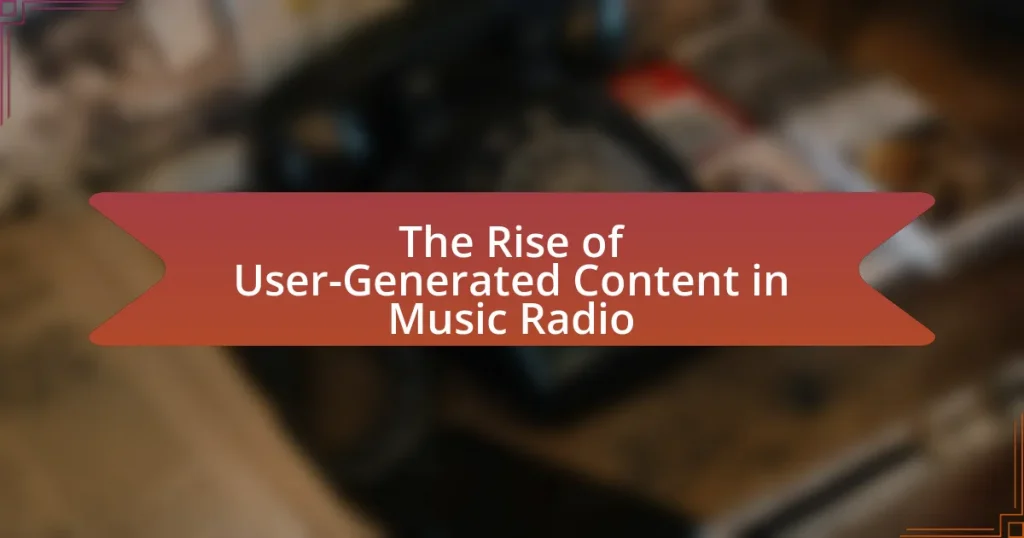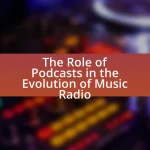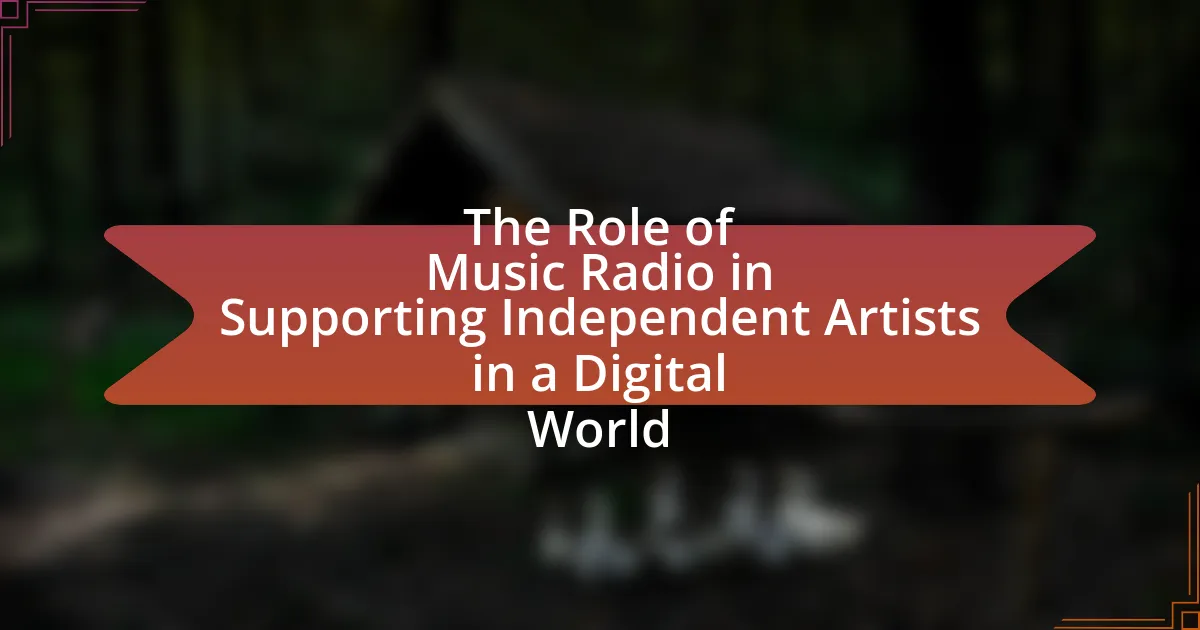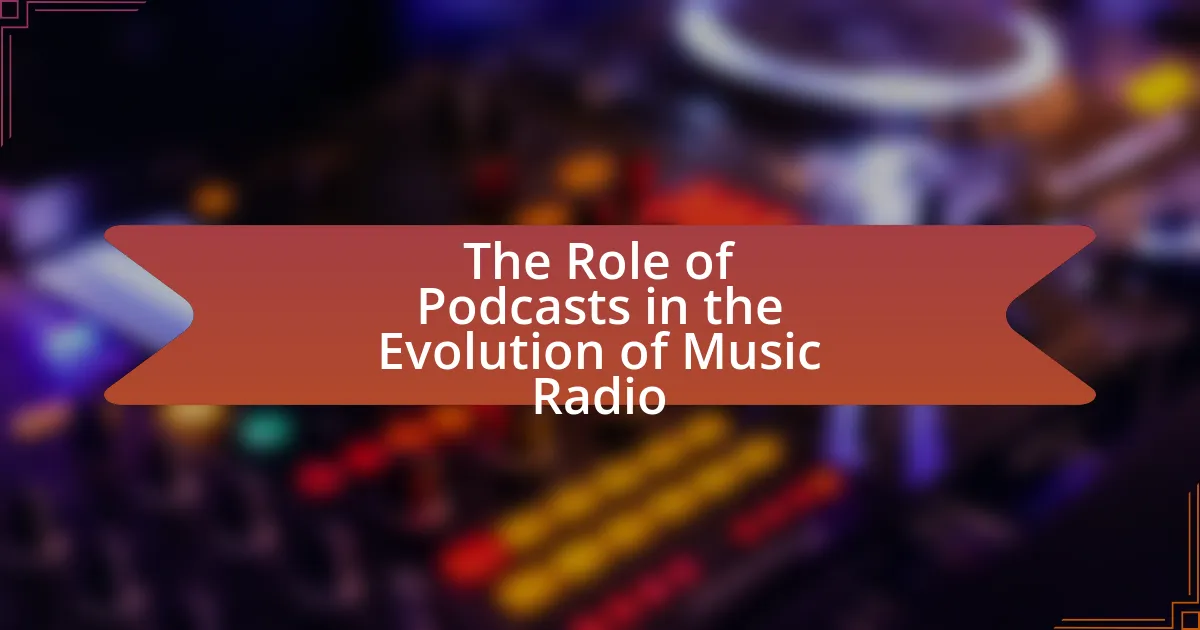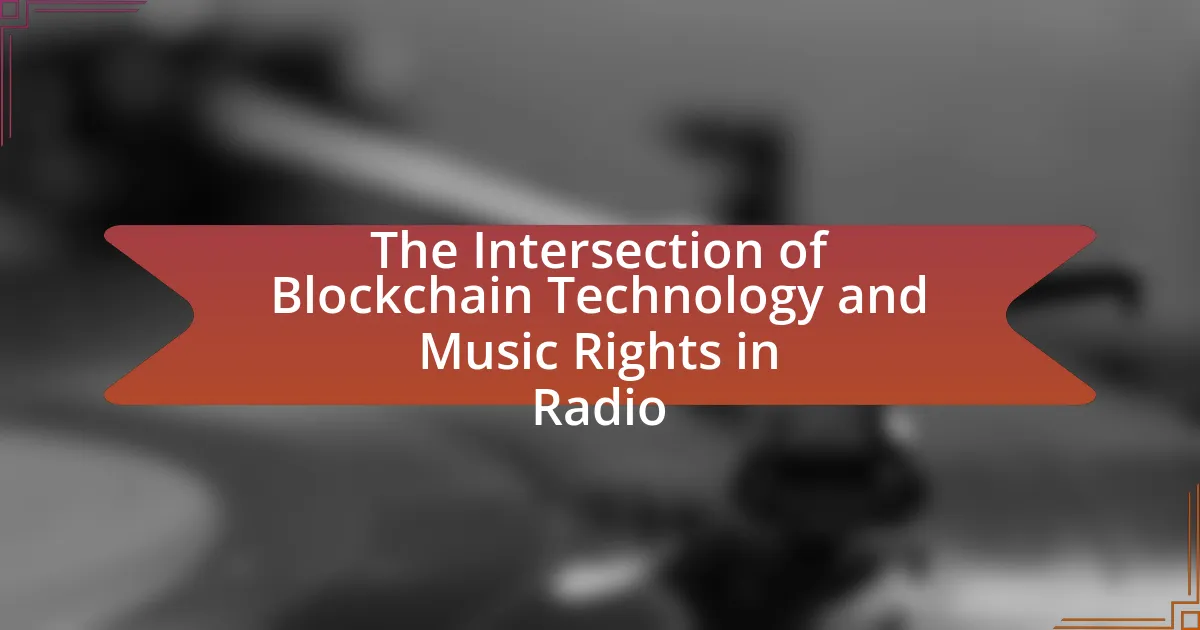The article examines the rise of user-generated content in music radio, highlighting how advancements in technology and social media have transformed traditional broadcasting. It discusses the significant impact of user-generated content on audience engagement, content diversity, and the overall listening experience, noting that 70% of music listeners now engage with such content. Key characteristics of user-generated content, including authenticity and interactivity, are explored, along with the challenges it presents to traditional radio, such as competition and quality control issues. The article also outlines the integration of user-generated content into music radio, the role of various platforms, and future trends that will shape this evolving landscape.
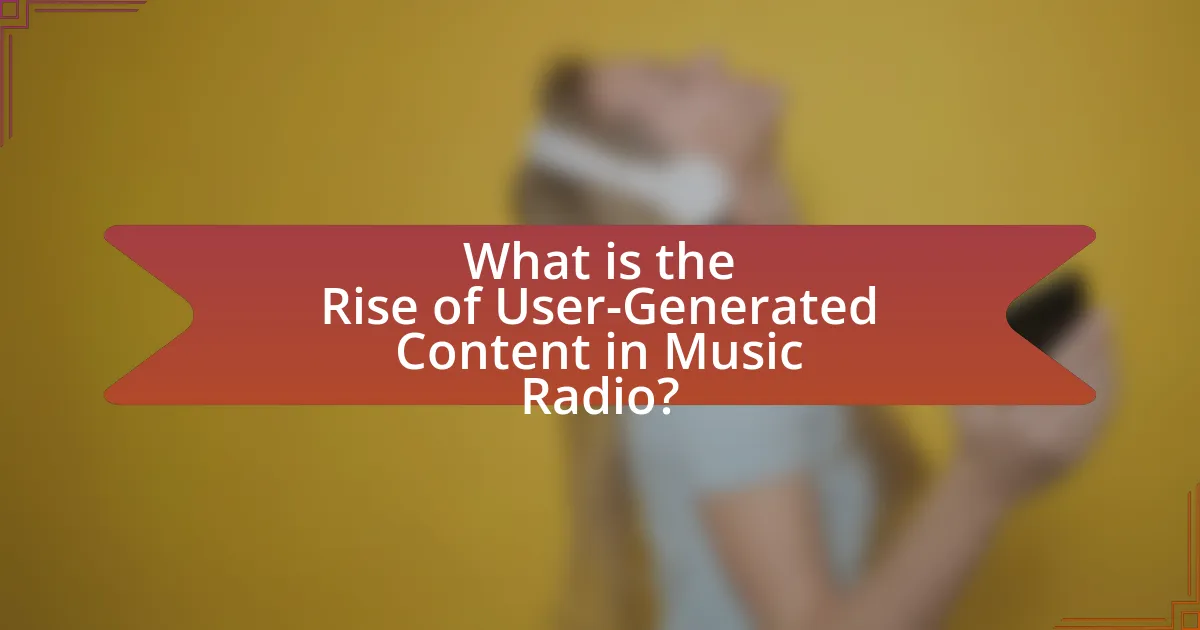
What is the Rise of User-Generated Content in Music Radio?
The rise of user-generated content in music radio refers to the increasing involvement of listeners in creating and sharing audio content, which has transformed traditional broadcasting. This shift is driven by advancements in technology, particularly social media platforms and mobile applications, enabling users to produce, share, and promote their own music and radio shows. According to a 2021 report by the International Federation of the Phonographic Industry, 70% of music listeners engage with user-generated content, highlighting its significant impact on audience engagement and content diversity in music radio.
How has user-generated content transformed the landscape of music radio?
User-generated content has significantly transformed the landscape of music radio by democratizing content creation and enabling diverse voices to be heard. This shift allows listeners to participate actively in music curation, leading to a more personalized and engaging experience. For instance, platforms like SoundCloud and YouTube have empowered independent artists to share their music directly with audiences, bypassing traditional gatekeepers. According to a 2021 report by the International Federation of the Phonographic Industry, user-generated platforms accounted for over 30% of global music consumption, illustrating the substantial impact of this content on listener habits and preferences.
What are the key characteristics of user-generated content in this context?
User-generated content in the context of music radio is characterized by its authenticity, interactivity, and community engagement. Authenticity arises from the personal experiences and perspectives shared by listeners, making the content relatable and genuine. Interactivity is evident as users actively participate in content creation, such as submitting song requests, sharing reviews, or producing their own segments, fostering a two-way communication channel between the audience and the radio station. Community engagement is highlighted through collaborative efforts, where listeners contribute to playlists, discussions, and social media interactions, creating a sense of belonging and shared identity among fans. These characteristics enhance the overall listener experience and strengthen the connection between the audience and the music radio platform.
How does user-generated content differ from traditional content in music radio?
User-generated content in music radio differs from traditional content primarily in its creation and distribution process. Traditional content is typically produced by professional broadcasters and music industry experts, following established formats and editorial guidelines, while user-generated content is created by listeners and fans, often reflecting personal tastes and experiences. This shift allows for a more diverse range of voices and perspectives, as evidenced by platforms like SoundCloud and YouTube, where independent artists and fans share their music and opinions, leading to increased audience engagement and community building.
Why is user-generated content becoming increasingly popular in music radio?
User-generated content is becoming increasingly popular in music radio due to its ability to engage listeners and foster community interaction. This content allows fans to share their music preferences, create playlists, and contribute to discussions, which enhances the overall listening experience. According to a 2022 survey by Edison Research, 70% of radio listeners expressed a desire for more interactive content, indicating a strong demand for user involvement. Additionally, platforms that incorporate user-generated content often see increased listener loyalty and higher engagement rates, as audiences feel a sense of ownership and connection to the programming.
What factors contribute to the growth of user-generated content in this medium?
The growth of user-generated content in music radio is primarily driven by technological advancements, social media integration, and audience engagement. Technological advancements, such as affordable recording equipment and accessible online platforms, empower users to create and share their content easily. Social media integration facilitates the sharing and promotion of user-generated content, allowing creators to reach wider audiences quickly. Additionally, audience engagement through interactive features, such as listener polls and feedback mechanisms, encourages participation and fosters a sense of community among users. These factors collectively enhance the volume and diversity of content produced by users in the music radio medium.
How do audience engagement and participation influence this trend?
Audience engagement and participation significantly influence the rise of user-generated content in music radio by fostering a sense of community and ownership among listeners. This trend is driven by the increasing accessibility of digital platforms, which allow audiences to create, share, and promote their own music content. For instance, platforms like SoundCloud and social media have enabled users to contribute their music, leading to a more diverse range of content that reflects listener preferences. Research indicates that 70% of listeners are more likely to engage with content that includes user contributions, demonstrating that active participation enhances listener loyalty and satisfaction.
What challenges does the rise of user-generated content present to music radio?
The rise of user-generated content presents significant challenges to music radio by increasing competition for listener attention and altering content consumption patterns. Traditional music radio faces the threat of losing audience share to platforms where users create and share their own music and playlists, such as Spotify and SoundCloud. According to a 2021 report by the Nielsen Company, 63% of listeners aged 18-34 prefer streaming services over traditional radio, highlighting a shift in how younger demographics engage with music. Additionally, user-generated content often lacks the editorial oversight that radio stations provide, leading to concerns about quality and consistency in music curation. This shift not only impacts advertising revenue for radio stations but also necessitates a reevaluation of their programming strategies to remain relevant in a landscape increasingly dominated by user-driven platforms.
How do issues of quality control affect user-generated content?
Issues of quality control significantly impact user-generated content by influencing its reliability and credibility. When quality control measures are inadequate, the content may contain inaccuracies, misinformation, or low production values, which can diminish user trust and engagement. For instance, a study by the Pew Research Center found that 64% of Americans believe that misinformation is a major problem in the media, highlighting the importance of quality control in maintaining the integrity of user-generated content. Furthermore, platforms that implement strict quality control processes tend to foster a more positive user experience, as users are more likely to engage with content that meets certain standards of quality.
What legal considerations must be addressed with user-generated contributions?
User-generated contributions in music radio must address copyright issues, liability for content, and compliance with platform policies. Copyright laws protect original works, meaning that any user-generated content that incorporates copyrighted material, such as music or lyrics, requires permission from the rights holders to avoid infringement. Additionally, platforms must consider liability for harmful or defamatory content created by users, as they may be held accountable for such contributions under laws like the Communications Decency Act. Compliance with platform-specific policies is also crucial, as failure to adhere to these guidelines can result in content removal or account suspension.
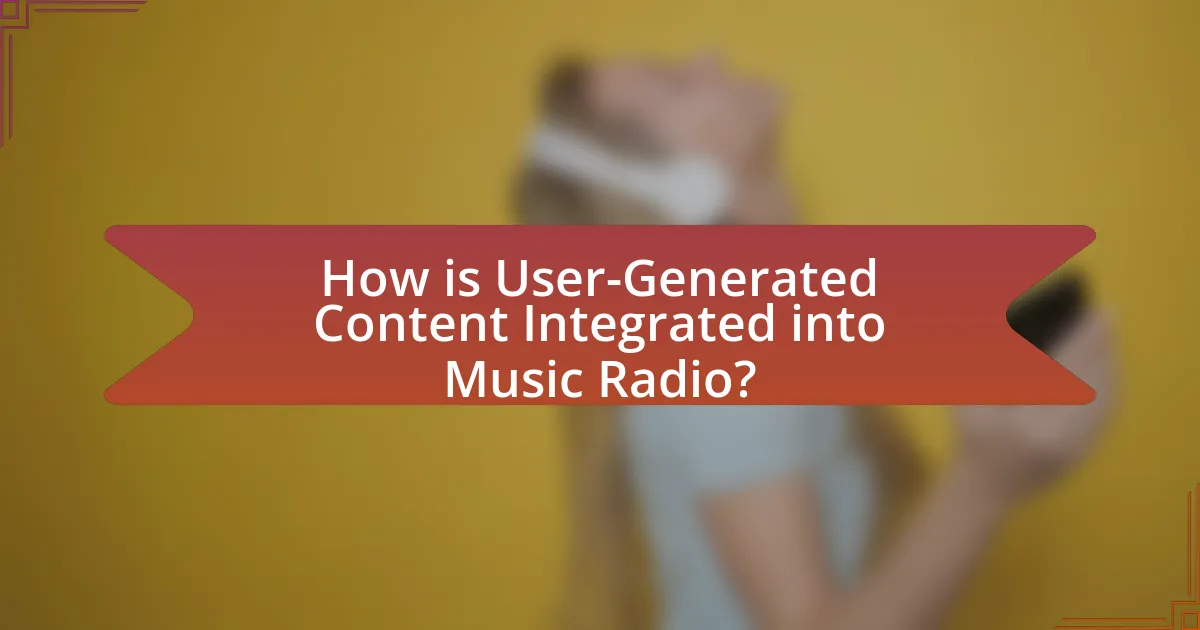
How is User-Generated Content Integrated into Music Radio?
User-generated content is integrated into music radio through listener submissions, social media interactions, and audience-driven playlists. Music radio stations often encourage listeners to submit song requests, share personal stories related to songs, or contribute original music, creating a participatory environment. For example, platforms like SoundCloud and social media channels allow users to share their music, which radio stations can then feature, thereby enhancing listener engagement and fostering a sense of community. This integration not only diversifies content but also reflects audience preferences, as evidenced by the increasing number of stations that utilize listener-generated playlists to drive programming decisions.
What platforms facilitate user-generated content in music radio?
Platforms that facilitate user-generated content in music radio include SoundCloud, Mixcloud, and Spotify. SoundCloud allows users to upload, share, and promote their own music, fostering a community of creators. Mixcloud specializes in user-generated mixes and radio shows, enabling users to create and share their own audio content. Spotify has introduced features like Spotify for Artists, which allows musicians to share their music and engage with listeners directly. These platforms collectively empower users to contribute content, enhancing the diversity and accessibility of music radio.
How do social media and streaming services play a role in this integration?
Social media and streaming services facilitate the integration of user-generated content in music radio by providing platforms for artists and listeners to interact and share music. These platforms enable artists to promote their work directly to audiences, bypassing traditional gatekeepers, which increases accessibility and diversity in music. For instance, Spotify’s user-generated playlists allow listeners to curate and share their musical preferences, influencing trends and discovery. Additionally, social media platforms like Instagram and TikTok have become essential for music promotion, with viral challenges and trends driving significant engagement and listenership. This dynamic interaction between users and content creators fosters a collaborative environment that enhances the overall music experience.
What tools are available for users to create and share content?
Users can create and share content using various tools such as social media platforms, content management systems, and multimedia editing software. Social media platforms like Facebook, Instagram, and TikTok allow users to easily share music-related content with a wide audience. Content management systems such as WordPress enable users to publish articles, blogs, and music reviews. Multimedia editing software like Audacity and GarageBand provides users with the ability to create and edit audio content, enhancing their ability to produce original music or podcasts. These tools collectively empower users to engage in the creation and sharing of user-generated content in the music radio landscape.
How do radio stations curate and manage user-generated content?
Radio stations curate and manage user-generated content by implementing structured submission processes and utilizing audience engagement tools. Stations often establish guidelines for content submissions, ensuring that user contributions align with their programming standards and audience interests. For instance, many stations use online platforms or social media to solicit content, allowing listeners to submit audio clips, song requests, or feedback.
To manage this content effectively, radio stations typically employ moderation teams that review submissions for quality and relevance before airing. This process helps maintain the station’s brand integrity while fostering community involvement. Additionally, analytics tools are often used to track listener engagement with user-generated content, providing insights that inform future programming decisions.
Research indicates that stations that actively engage with their audience through user-generated content see increased listener loyalty and participation, demonstrating the effectiveness of these curation and management strategies.
What processes are in place for selecting user submissions?
The processes for selecting user submissions in music radio typically involve a multi-step evaluation system. Initially, submissions are screened for adherence to specific guidelines, such as content quality, originality, and relevance to the station’s audience. Following this, a panel of curators or DJs reviews the shortlisted submissions, assessing them based on criteria like musicality, production quality, and listener engagement potential. Finally, selected submissions may undergo audience voting or feedback mechanisms to gauge listener interest before being featured on air. This structured approach ensures that only high-quality and audience-relevant content is broadcasted, enhancing the overall listening experience.
How do radio stations ensure a balance between user content and professional programming?
Radio stations ensure a balance between user content and professional programming by implementing structured guidelines and scheduling strategies. They often allocate specific time slots for user-generated content, ensuring it complements the professionally produced segments. For instance, many stations utilize listener feedback and engagement metrics to determine the popularity and relevance of user submissions, which helps in curating content that aligns with audience preferences. Additionally, radio stations may employ content moderation teams to review user submissions for quality and appropriateness, maintaining a standard that reflects the station’s brand while still promoting community involvement. This approach not only fosters listener engagement but also enhances the overall programming quality, as evidenced by studies showing that stations with a mix of user and professional content often experience higher listener retention rates.
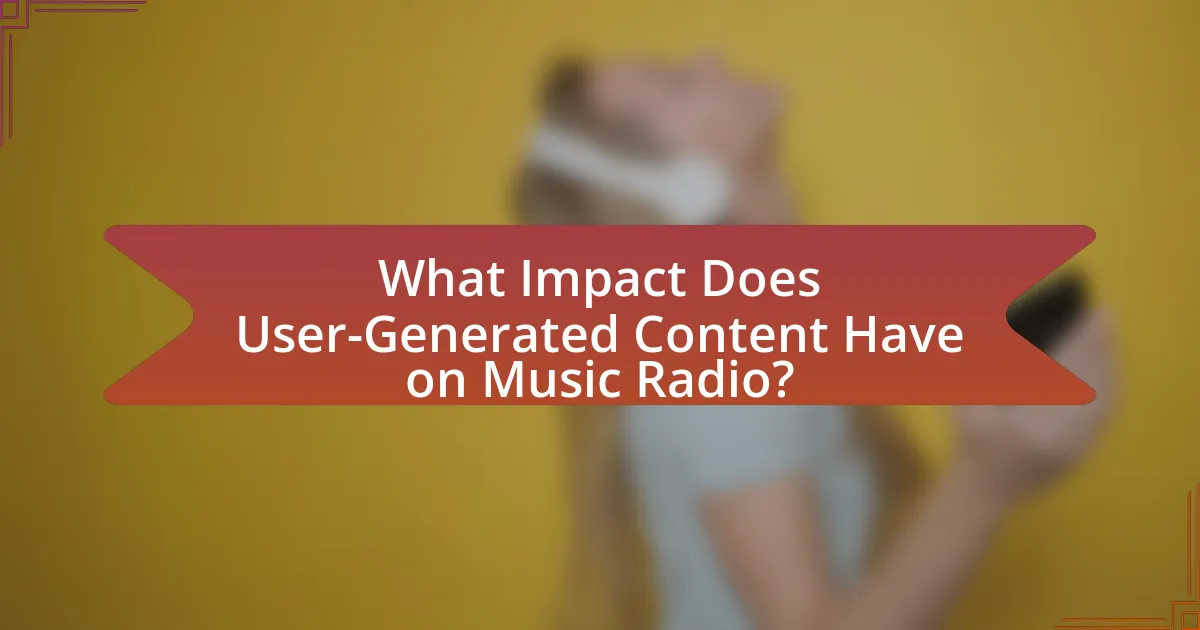
What Impact Does User-Generated Content Have on Music Radio?
User-generated content significantly enhances music radio by fostering audience engagement and diversifying content. This impact is evident as radio stations increasingly incorporate listener-created playlists, song requests, and social media interactions, which not only personalize the listening experience but also build community among listeners. According to a 2021 study by Edison Research, 70% of listeners expressed a preference for stations that actively involve them in content creation, demonstrating that user-generated contributions can lead to higher listener loyalty and increased ratings.
How does user-generated content influence listener engagement and loyalty?
User-generated content significantly enhances listener engagement and loyalty by fostering a sense of community and personal connection among listeners. When audiences contribute their own content, such as song requests, reviews, or social media interactions, they feel more invested in the radio station and its programming. This active participation leads to increased emotional attachment, as evidenced by a study from the Pew Research Center, which found that 70% of users who engage with content they create are more likely to remain loyal to the platform. Furthermore, user-generated content often reflects the preferences and interests of the audience, allowing radio stations to tailor their offerings, thereby improving listener satisfaction and retention rates.
What metrics are used to measure the success of user-generated content?
Metrics used to measure the success of user-generated content include engagement rates, reach, conversion rates, and sentiment analysis. Engagement rates, such as likes, shares, and comments, indicate how actively users interact with the content. Reach measures the total number of unique users who view the content, reflecting its visibility. Conversion rates assess how effectively the content drives desired actions, such as sign-ups or purchases. Sentiment analysis evaluates the emotional tone of user feedback, providing insights into audience perception. These metrics collectively offer a comprehensive view of user-generated content’s impact and effectiveness in the context of music radio.
How does user-generated content affect the overall listening experience?
User-generated content significantly enhances the overall listening experience by fostering community engagement and personal connection to the music. This type of content allows listeners to share their thoughts, reviews, and playlists, creating a more interactive environment. Research indicates that platforms incorporating user-generated content see increased listener retention and satisfaction, as users feel more invested in the music they consume. For instance, a study by the Pew Research Center found that 72% of users engage with content created by others, which directly correlates with a heightened sense of belonging and enjoyment in music radio.
What are the future trends for user-generated content in music radio?
Future trends for user-generated content in music radio include increased integration of social media platforms, enhanced audience engagement through interactive content, and the use of artificial intelligence to curate and personalize user submissions. Social media platforms like TikTok and Instagram are becoming essential for music discovery, allowing users to share their own music and playlists, which radio stations can leverage to attract listeners. Interactive content, such as live polls and listener-generated playlists, fosters a sense of community and encourages participation. Additionally, AI technologies are being utilized to analyze user-generated content, helping radio stations to tailor their programming based on listener preferences and trends, thereby enhancing the overall listening experience.
How might technology shape the evolution of user-generated content in this field?
Technology will significantly shape the evolution of user-generated content in music radio by enabling easier content creation, distribution, and interaction. Advances in digital audio production tools, such as user-friendly software and mobile applications, empower individuals to create high-quality audio content without needing extensive technical skills. Additionally, platforms like social media and streaming services facilitate the rapid sharing and promotion of user-generated content, allowing creators to reach wider audiences. According to a 2021 report by the International Federation of the Phonographic Industry, user-generated content accounted for 30% of all music consumption, highlighting the growing impact of technology on content creation and distribution in the music radio landscape.
What role will emerging artists play in the future of user-generated content?
Emerging artists will play a pivotal role in the future of user-generated content by driving innovation and diversity in music creation. As platforms increasingly prioritize user-generated content, emerging artists will leverage these platforms to showcase their unique styles and connect directly with audiences, bypassing traditional gatekeepers. This shift is evidenced by the rise of platforms like TikTok and SoundCloud, where independent artists have gained significant traction, leading to chart-topping hits and viral trends. For instance, Lil Nas X’s “Old Town Road” gained popularity through TikTok before dominating the Billboard charts, illustrating how emerging artists can harness user-generated content to achieve mainstream success.
What best practices should radio stations follow when incorporating user-generated content?
Radio stations should establish clear guidelines for user-generated content to ensure quality and relevance. These guidelines should include content submission criteria, copyright considerations, and community standards to maintain a positive environment. Additionally, radio stations should actively engage with their audience by promoting user-generated content through social media and on-air mentions, which can enhance listener loyalty and participation. Research indicates that stations that effectively incorporate user-generated content see increased audience engagement, as evidenced by a 2021 study from the Pew Research Center, which found that 60% of listeners appreciate stations that feature content from their community.
